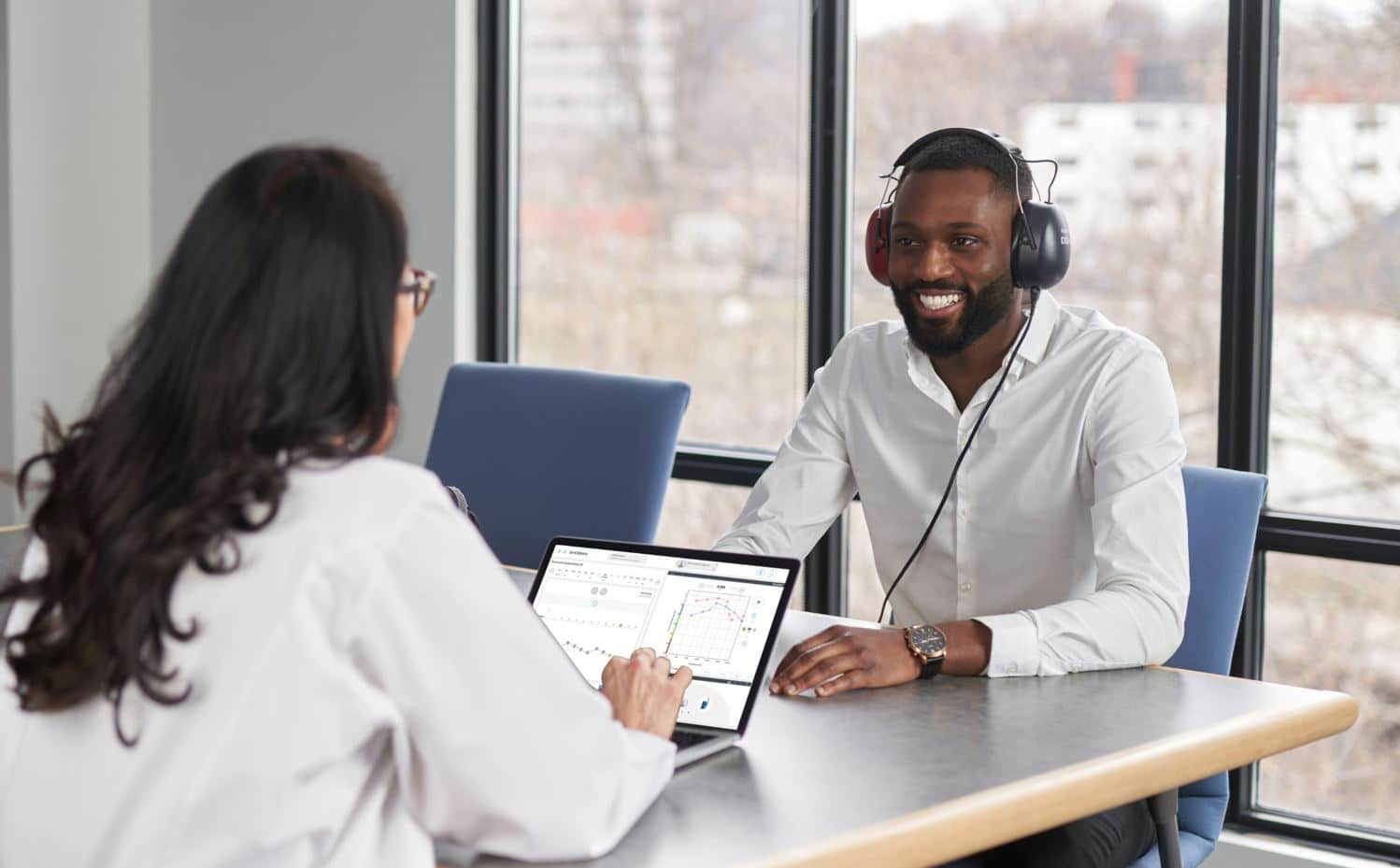Many believe a clinically valid audiometric test must occur in a sound booth. This rationale is based on the assumption that only a sound booth can eliminate background noise and possible distractions that may lead to inaccurate test results. However, recent advances in audiometric technology are enabling a shift to testing outside of the booth. This shift is being widely embraced by both hearing healthcare professionals and patients.
In addition to expanding available and appropriate hearing testing locations, there are also advantages to testing outside of a sound booth. This can include a better patient experience for those uncomfortable in confined spaces and a better clinician-patient connection during testing, which can be especially helpful for those for whom hearing testing is stressful.

Boothless audiometry offers many benefits to the busy clinician
From a business perspective, maximizing clinic spaces other than the booth can help increase the return on investment on room space. It can help lower the wait times for basic evaluations, not to mention providing a viable option for those unplanned additional tests or ENT clinic add-ons.
Additionally, boothless audiometry allows for improved access for patients with reduced or restricted mobility, as many traditional booths are not wheelchair accessible.
Patient Experience
Some patients feel claustrophobic and uncomfortable while seated in a small, soundproof audiometric booth. An anxious patient may not provide accurate results because they are worried or preoccupied.
“If I feel that my patient is struggling during the testing session, I’m going to do my utmost to make them as comfortable as possible. I might opt to use web-based SHOEBOX, which is an audiometer optimized for use outside of a sound booth so that I can continue to be in the same room as that person to provide them additional encouragement and support”
–Renée Lefrançois, Director of Audiology at SHOEBOX
Additionally, the mobility constraints of a sound booth may be problematic for patients that require assistance. To achieve effective sound blockage from the outside, many double-walled sound booths have a door ledge or series of ledges that can be hazardous. A typical sound booth floor area is approximately eight square feet or less. Maneuvering can be a concern for some patients with mobility restrictions, especially with the added requirement of a wheelchair or walker.
Increase Efficiency
SHOEBOX makes it easy to perform hearing testing and screening that can power a wide range of processes. These workflows can include fully remote screening, mobile diagnostic testing, and automated basic testing. Using SHOEBOX’s pre-screening products can help determine who to prioritize and ensure a full diagnostic test only for those who need it.
In addition, in a busy clinic, every day is different and every patient’s needs are different. Sometimes you have add-on patients, especially in ENT clinics. These patients come in for a medical evaluation but may have erroneously not been scheduled for a hearing test. SHOEBOX is ideally suited as a solution for add-on patients who may have had to wait months for an appointment.
Save Money and Reduce Backlogs
The investment in a sound booth is high. Alberto Behar outlines in his 2020 article in the Canadian Audiologist, “There are some inherent problems associated with audiometric sound booths. The first and most obvious is the cost of the device, typically starting at $4,000.”1
In addition, the square footage a sound booth takes up in a clinic is costly. “The more sophisticated the booth is, the more space it requires, as is its mass. If there is a need also to isolate the audiometric operator, then a double room is required, and more space has to be allocated.”1
The average U.S. retail space renting for approximately $23.00 per square foot is valuable real estate that could be used for more profitable activities. Supplementing the clinic’s existing sound booth with SHOEBOX audiometric testing allows more patients to be tested without incurring the cost of another sound booth which can significantly reduce backlog issues for busy clinics.
Patient no-shows are a costly problem, both for providers as well as for patient outcomes. The 2023 Medicare Proposed Physician Fee Schedule2 outlines the various fees for different audiological tests. A missed appointment is missed revenue. Additionally, if a patient misses a sound booth appointment, instead of waiting months to be re-booked, they can quickly be scheduled for a mobile test to determine the need for more diagnostic testing.
Other cost necessities include calibrations and upkeep of the sound booth itself. ANSI requirements state that calibrations of a sound booth take place annually. In addition, over time, the booth will get older and require general maintenance. Another costly consideration with respect to enclosed sound booths is the need to disinfect the area, and the time required to circulate air, between patients. A typical sound booth appointment can take up to an hour to complete and, based on the clinic’s ventilation systems, may require 15 – 20 minutes between patients. The room must be cleaned, disinfected and ventilated between each patient. Mobile testing can be used in alternate quiet rooms in the clinic throughout the day to help bridge those timing gaps.

Conclusion
Behar’s article in the Canadian Audiologist states, “Results of studies support the use of alternative means that allows obtaining similar results to a sound booth. The key issue is maintaining and controlling the background noise levels so that the hearing of the subject being tested is not affected.”1
SHOEBOX incorporates several sets of Maximum Permissible Ambient Noise Levels (MPANLs) to choose from depending on the local regulations (ANSI or OSHA). Should these levels be exceeded during a testing session, SHOEBOX will alert the administrator with several types of configurable notifications.
SHOEBOX is an ideal complement to the in-clinic booth with its ability to conduct accurate audiometric assessments in any relatively quiet environment, improve processes with new workflows and create a pleasant alternative to an enclosed sound booth, all while lowering expenses.
There are several key benefits to adding boothless testing to your clinic offering; the bottom line is that SHOEBOX offers multiple noise-monitored testing options and the flexibility to use your office space efficiently in order to help you better meet the needs of your patients.
References:
- Alberto Behar, P. (2020). Do We Really Need an Audiometric Booth? Canadian Audiologist.
- 2023 Proposed Rule – Medicare Physician Fee Schedule
 Nancy Groen, M.Sc, Reg. CASLPO, CAOHC CPS/A, In-House Audiologist. Nancy Groen has been practicing audiology since she graduated from Dalhousie University in 2012. She joined SHOEBOX Ltd. in January 2023 as in-house audiologist. Prior to joining SHOEBOX, Nancy practiced as a clinical and dispensing audiologist with experience in diagnostics as well as hearing aid evaluations and fittings. Nancy is a contributing member to the College of Audiologists and Speech-Language Pathologists of Ontario (CASLPO) and she recently received her certification as a Professional Supervisor through the Council for Accreditation in Occupational Hearing Conservation (CAOCH).
Nancy Groen, M.Sc, Reg. CASLPO, CAOHC CPS/A, In-House Audiologist. Nancy Groen has been practicing audiology since she graduated from Dalhousie University in 2012. She joined SHOEBOX Ltd. in January 2023 as in-house audiologist. Prior to joining SHOEBOX, Nancy practiced as a clinical and dispensing audiologist with experience in diagnostics as well as hearing aid evaluations and fittings. Nancy is a contributing member to the College of Audiologists and Speech-Language Pathologists of Ontario (CASLPO) and she recently received her certification as a Professional Supervisor through the Council for Accreditation in Occupational Hearing Conservation (CAOCH).






